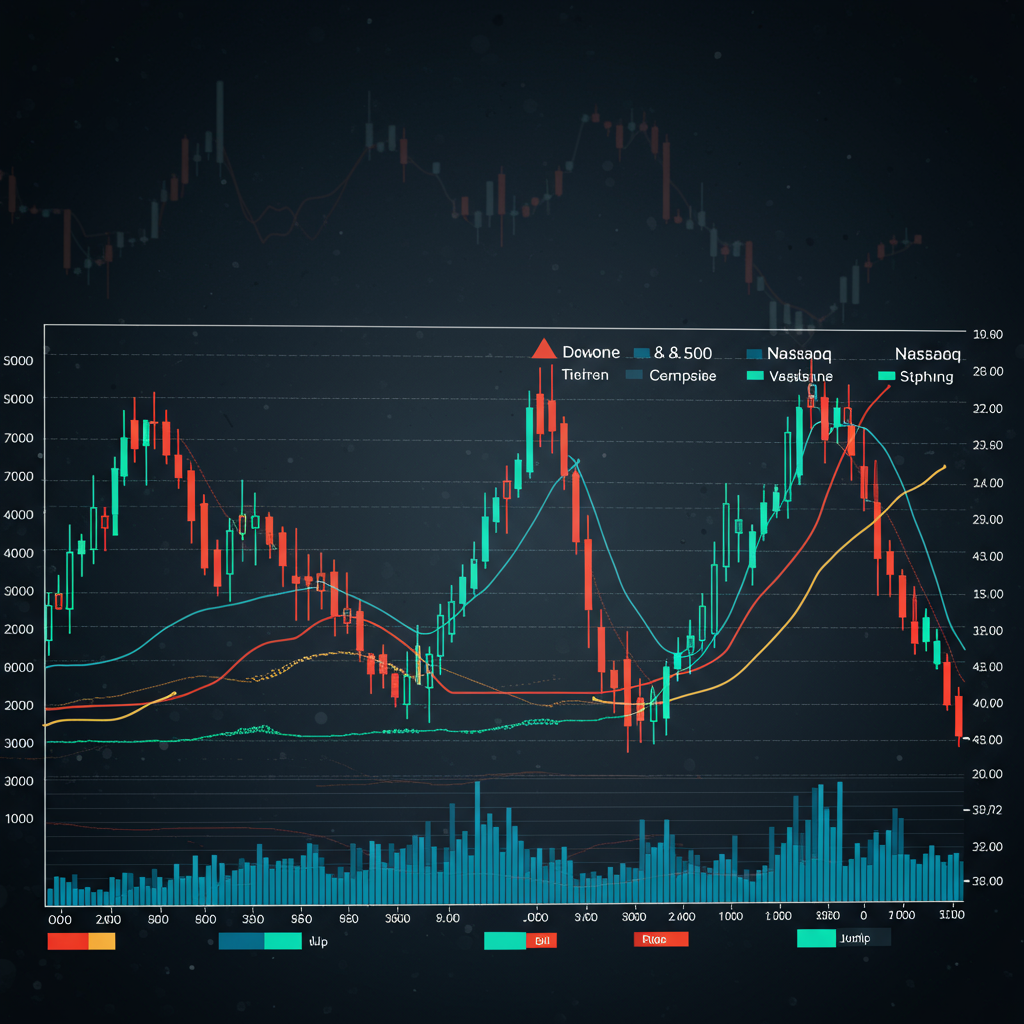The U.S. stock market navigated a complex landscape on Wednesday, October 29, 2025, as the Federal Reserve delivered an anticipated interest rate cut while Chair Jerome Powell offered a cautious outlook on future monetary policy. While tech giant Nvidia achieved a historic valuation, the broader market experienced a mixed reaction, with the Dow Jones Industrial Average and S&P 500 reversing early gains to end lower. Investors grappled with the implications of the Fed’s decision, Powell’s nuanced comments, and a flurry of corporate earnings that painted a picture of an economy in transition. This pivotal day highlighted persistent inflation concerns, a softening labor market, and the enduring influence of the artificial intelligence boom on market dynamics.
The Federal Reserve’s Calculated Move and Powell’s Cautionary Stance
On Wednesday, the Federal Reserve opted for its second interest rate cut of the year, reducing the benchmark rate by a quarter-point as widely expected. This move aimed to stimulate economic activity amidst signs of cooling, yet the decision was not unanimous, reflecting internal divisions. Fed Governor Stephen Miran advocated for a more aggressive 50-basis-point cut, while Kansas City Fed President Jeff Schmid preferred holding rates steady, signaling varied perspectives within the central bank on the appropriate path forward.
Powell’s Nuanced Outlook on Future Cuts
Following the rate decision, Chair Jerome Powell’s press conference became the focal point for market participants. He significantly tempered expectations for further easing, stating that an additional rate reduction at the upcoming December meeting was “far from” a certainty. Powell emphasized that “policy is not on a preset course,” and the Fed would remain data-dependent. He acknowledged “strongly differing views” among committee members and cited “two-sided risks” to the economy – persistent inflation tilted to the upside and potential labor market weakness leaning to the downside. These remarks prompted a shift in market sentiment, leading to a pull-back in major indices that had initially climbed on the news of the rate cut.
Powell also noted the early stages of assessing the economic impact of potential tariffs, indicating “no decisions” had been made regarding future cuts and that two rounds of inflation and labor market reports would be critical for subsequent deliberations. This consistent theme of prudence aimed to prevent an overreaction to the rate cut and maintain the Fed’s flexibility.
Nvidia’s Historic Ascent and the AI Investment Frenzy
Amidst the Fed’s policy deliberations, Nvidia (NVDA) delivered a spectacular performance, surging to push its market capitalization above an unprecedented $5 trillion. This made it the first company in history to reach such a milestone, underscoring the immense investor confidence in the AI sector’s growth potential.
AI Boom: Bubble or Sustainable Growth?
Nvidia’s monumental jump was partly fueled by renewed optimism for easing curbs on its sales in China, following indications that President Trump might discuss the company’s advanced Blackwell AI processors with Chinese President Xi. This momentum extended from the previous day’s record high close, driven by announcements from its GTC event, where CEO Jensen Huang declared the AI industry had “turned a corner” and entered a “virtuous cycle.”
Powell, addressing comparisons between the current AI-driven market rally and the 1990s dot-com bubble, pushed back on the notion of an unsustainable boom. He argued that today’s highly valued tech leaders possess “earnings and stuff like that,” along with “business models, profits, and earnings,” distinguishing them from the “ideas rather than companies” that characterized the earlier bubble. He pinpointed AI-related investments in data centers, chips, and infrastructure as a significant catalyst for current economic growth, providing a fundamental basis for the market’s enthusiasm.
Dissecting the Labor Market and Inflation Landscape
The Federal Reserve’s cautious stance was also informed by an evolving understanding of the labor market and persistent inflationary pressures. Powell provided a nuanced view on both, highlighting areas of concern and signs of improvement.
Signs of Strain in the Job Market
Powell acknowledged increasing indications of stress within the employment sector. High-profile layoffs at major companies, including Amazon and UPS, contributed to this concern. He stated the Fed is “watching very, very, very carefully” as more companies announce hiring freezes or workforce reductions, often citing AI as a factor in efficiency gains. The full impact of these announcements on official job growth data typically manifests over time, suggesting potential future weakness. Furthermore, Powell pointed to a “bifurcated economy,” where lower-income consumers are curtailing spending due to financial pressures, while higher earners maintain their spending habits—a trend supported by extensive anecdotal evidence. This follows earlier signals from August’s weak jobs report and declining consumer confidence in job security.
Navigating Persistent Inflation Challenges
Despite inflation hovering around 3%, Powell presented a detailed assessment, suggesting that underlying inflation might be closer to the Fed’s 2% target. He attributed sticky goods prices primarily to tariffs, rather than broad-based price pressures, noting that the September CPI report was “a little softer than expected.” Significantly, he highlighted that housing inflation is finally showing sustained improvement and is projected to continue declining. In contrast, services inflation (excluding housing) has remained stubbornly sideways. Powell estimated that, without the impact of tariffs, underlying inflation is likely around 2.3% to 2.4%, just slightly above the target, reiterating the Fed’s commitment to achieving its 2% inflation goal.
Key Corporate Players and Market Reaction
Beyond the macroeconomic factors, corporate earnings and strategic announcements played a crucial role in shaping individual stock performances and overall market sentiment. Investors keenly awaited results from the technology sector, a dominant force in the current market.
Anticipation Builds for “Magnificent Seven” Earnings
The market braced for a wave of quarterly results from the “Magnificent Seven” tech megacaps. Alphabet, Meta Platforms, and Microsoft were scheduled to report after Wednesday’s close, with Apple and Amazon following on Thursday. Analysts widely anticipated another round of substantial data center spending, reflecting the ongoing AI investment boom. A key focus for investors was the profitability and efficiency of these continued AI investments, as any disappointment could trigger a negative reaction across the broader tech-heavy market.
Google parent Alphabet (GOOG) was expected to report robust Q3 revenue and adjusted EPS, though its growth rate was projected to be its lowest in over two years, partly due to an EU antitrust fine. The company stands as a primary beneficiary of the AI boom through its Gemini AI models and extensive cloud services. However, it also faces increasing risks to its core Search business from the rise of powerful AI chatbots like OpenAI’s ChatGPT. Amazon (AMZN) further underscored the AI chip arms race by announcing a massive data center project completion and a significant deal for Anthropic to utilize one million of its custom AI chips by late 2025. This move is critical for Amazon Web Services (AWS) to maintain its competitive edge in the escalating AI chip market, especially as Anthropic also holds a substantial deal with Google for its custom TPUs.
Diverse Corporate Performance
While tech giants prepared for their spotlight, other sectors provided varied news. Construction and mining equipment giant Caterpillar (CAT) saw its stock surge over 12% after reporting a strong Q3 earnings beat and a better-than-expected Q4 outlook. The company’s Energy & Transportation segment demonstrated significant growth, and its positive forecast overshadowed concerns about increased full-year tariff impacts. In contrast, Etsy (ETSY) stock dropped approximately 9% following the announcement of a CEO change and despite beating Q3 earnings estimates. The decline was largely attributed to slowing demand impacting its core sales, indicating consumer discretionary spending remains under pressure in certain segments.
Broader Economic Indicators and Future Outlook
The market’s direction remains inextricably linked to the broader economic health, with various indicators and policy uncertainties influencing investor decisions. The Federal Reserve’s cautious posture on inflation and employment reflects an economy navigating complex crosscurrents.
The Tariff Wildcard
Tariffs continued to cast a shadow of uncertainty over the economic outlook. Powell acknowledged that ongoing trade negotiations had brought some clarity regarding an effective U.S. tariff rate of approximately 15%. However, he warned of “considerable uncertainty” regarding the ultimate economic impact, noting that the situation was “still a ways away from seeing where things settle down.” This uncertainty extends to how these tariffs influence domestic prices and consumer behavior. Notably, Fed Governor Christopher Waller had previously argued for “looking through” such price-level effects, believing the tariff-induced inflation boost would be “temporary” as long as inflation expectations remained anchored, suggesting divergent views on their long-term impact within the Fed.
Frequently Asked Questions
What was the Federal Reserve’s main decision on October 29, 2025, and how did it impact the stock market?
On October 29, 2025, the Federal Reserve cut its key interest rate by a quarter-point for the second time this year. While initial market reaction saw gains, stocks, particularly the Dow Jones Industrial Average and S&P 500, later slipped. This reversal was driven by Fed Chair Jerome Powell’s cautious statements, indicating that further rate cuts were “far from” certain and that the Fed saw “two-sided risks” to the economy, dampening investor enthusiasm for aggressive future easing.
What fueled Nvidia’s historic market valuation, and what does it signal for the AI sector?
Nvidia (NVDA) surged to a historic $5 trillion market valuation on October 29, 2025, becoming the first company to reach this milestone. This was primarily fueled by optimism for easing U.S. restrictions on its sales in China, coupled with ongoing excitement from its GTC event announcements. Fed Chair Powell highlighted that today’s AI leaders, unlike dot-com bubble companies, possess “earnings, business models, and profits,” signaling that the current AI boom is driven by tangible economic value and significant investments in data centers and chips.
How are Federal Reserve officials assessing the current labor market and inflation trends, and what are the key takeaways for investors?
Fed Chair Powell observed increasing strain in the labor market, citing high-profile layoffs and a “bifurcated economy” where lower-income consumers are curtailing spending. Regarding inflation, he noted underlying inflation is likely closer to 2%, attributing sticky goods prices to tariffs and expecting housing inflation to decline. For investors, the takeaway is to anticipate continued market volatility, as the Fed balances inflation risks against employment concerns. Monitoring upcoming tech earnings, Powell’s future statements, and economic data will be crucial for navigating this dynamic environment.
Conclusion: Navigating a Dynamic Market Landscape
October 29, 2025, served as a stark reminder of the complexities inherent in today’s financial markets. The Federal Reserve’s rate cut, while welcomed by some, was quickly tempered by Chair Powell’s cautious rhetoric, shifting investor focus from dovish expectations to economic realities. Nvidia’s historic $5 trillion milestone underscored the unparalleled influence of artificial intelligence, yet Powell’s nuanced comments urged prudence, distinguishing sustainable growth from speculative bubbles.
Investors must remain vigilant, paying close attention to upcoming corporate earnings reports – particularly from the “Magnificent Seven” tech giants – and future economic indicators. The interplay between central bank policy, technological innovation, and evolving economic data will continue to shape market trajectories. Understanding these forces and their potential impacts will be key for informed decision-making in this dynamic and often unpredictable market landscape.


